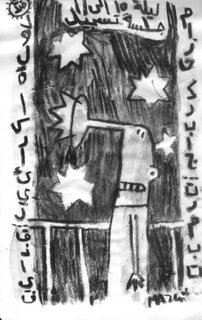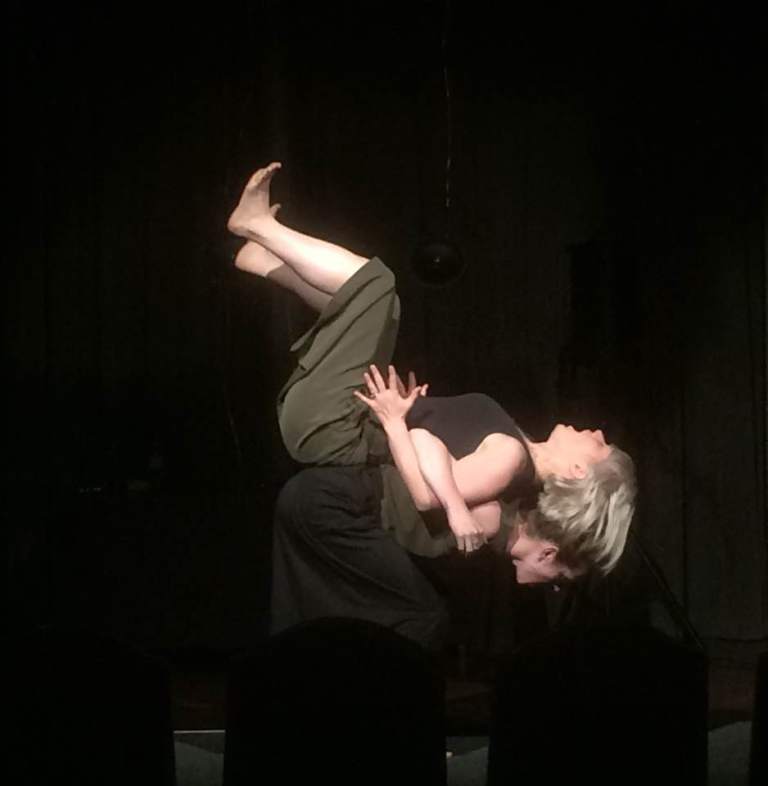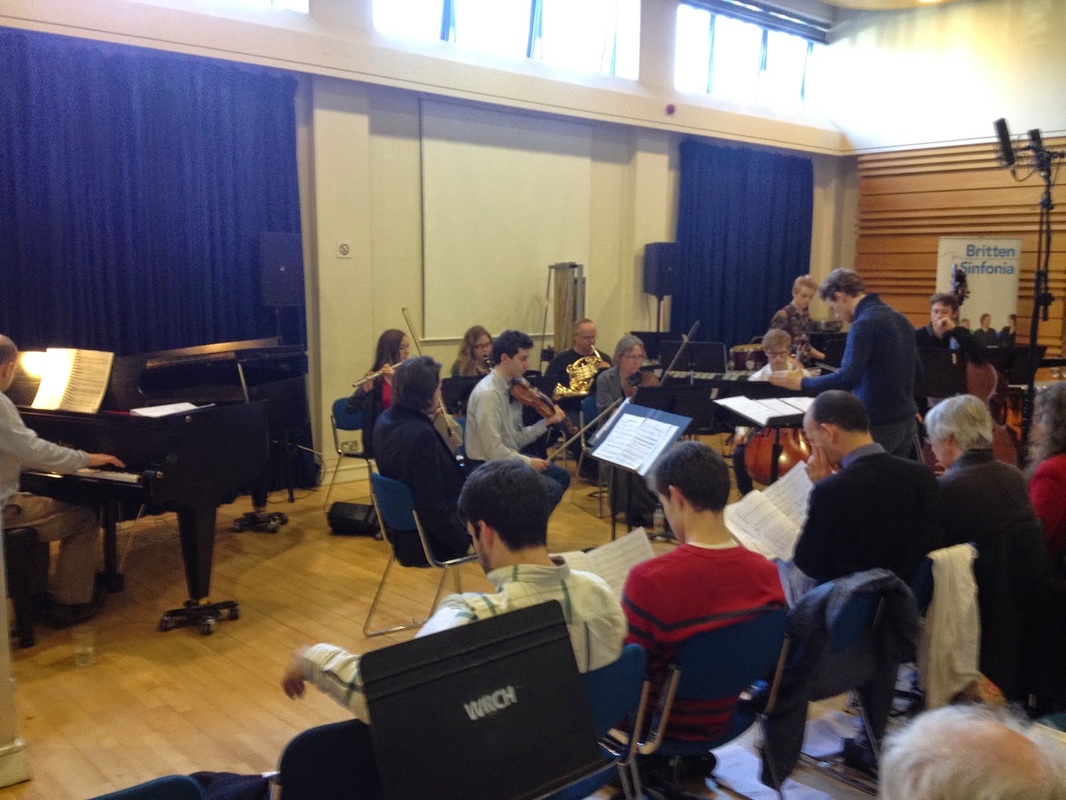|
Review by Simone Maurer for the 2017 Bendigo International Festival of Exploratory Music, Writers' Workshop. Originally published at: https://partialdurations.com/
BIFEM’s Argonaut Ensemble returned on the festival’s second night to perform two Australian premieres: Beyrouth15072006 by Israeli composer, Adam Maor, and Cycle ‘Canciones’ by Argentinian composer Santiago Diez-Fischer. Maor operated the live electronics in his own politically-charged composition, which was conducted by Elena Schwarz and featured trombone, trumpet, violin, viola, cello, double bass, and percussion. In a post-performance interview with BIFEM Director David Chisolm, Maor revealed that his work originated from a 40-minute recorded improvisation entitled Starry Night by the Lebanese trumpeter Mazen Kerbaj. This unnerving ‘duet’ between trumpet and Israeli bombings was recorded on 15th July 2006 in Beirut; thus the title of Maor’s composition. Even if Maor had not divulged the origin of his composition, a sense of this story was apparent in his musical treatment of the subject. Beirut’s anticipation and fear of the bombs was heard in the unstable string tremolos and fluttering brass breaths. The irregular, sinking trombone glissandi conjured sinister undertones of the approaching warplanes. The sounds of planes, a bomb strike, and sirens (from Kerbaj’s recording) were heard twice, framed by short instrumental phrases. Its narrative is clear and Maor mirrors the sounds in the ensemble: trumpet as sirens and sliding string harmonics as howling wind. As the piece closes, the trombone reiterates its sinking glissandi, this time growling and amplified. Gradually slowing and fading out, the warplanes have returned home. But Beirut does not sleep peacefully, waiting in fear for tomorrow. Diez-Fischer’s three songs (performed as a cycle) made a complete contrast to Maor’s linear narrative. Some audience members felt the songs were too thematically restrained or focussed, however credit is due to Diez-Fischer’s full exploration and exhaustion of the minimal musical material. All three songs varied upon a three-note phrase sung by soprano, Jane Sheldon, of which the lowest pitch was a vocal fry. Similar guttural frictions were also heard in the ensemble: scratching of the bow across the lap-held electric guitar, rushing air noises in the winds, and skimming bows across string instruments. Sheldon’s guttural repetitions at times seemed desperate to form words and the instrumentalists offered frequent, but short bursts of dialogue. Although I also felt frustrated, wanting to ‘liberate’ the performers from the tightly controlled and repetitive musical elements, my key to resolving this sensation was to surrender to the hyper-focussed material and enjoy the suspense. The Argonaut Ensemble members are Australian and international soloists brought together specifically for BIFEM. However, from their assured musical precision and communication, they have the refinements of a well-established ensemble. Particular commendation must be given to trombonist Charles MacInnes and soprano Jane Sheldon. MacInnes performed his part with virtuosity and stamina, while Sheldon displayed complete command and consistency of vocal production throughout the repetitive musical material of Cycle ‘Canciones’. Maintaining a striking physical stillness, she effortlessly executed the intervallic gymnastics required to quickly alternate between pure tone and vocal fry. The combination of musicians and compositions ensured this concert was a highlight of the festival. 15072006 Argonaut Ensemble Capital Theatre Bendigo International Festival of Exploratory Music 2 September, 2017 Adam Maor, BEYROUTH15072006; Santiago Diez-Fischer, Cycle ‘Canciones’
0 Comments
Review by Simone Maurer for the 2017 Bendigo International Festival of Exploratory Music, Writers' Workshop. Originally published at: https://partialdurations.com/
Dressed in loose-fitting black and khaki clothes, Jessica Aszodi and Jenna Lyle began Grafter centre stage, facing each other. The stage was equipped with microphones, hanging speakers, and electronic equipment on a desk. Standing motionless, Aszodi sang a sustained vowel-tone as Lyle swayed her upper body over Aszodi, purposely interrupting her vocal projection. This example of what the performers describe as “choreographically affecting sound” underpins the work, and highlights the use of body movements for sound effect, rather than visual effect. The performers’ body movements were not intended as a separate artistic element—they were integral to the sound production. In fact, there was little movement which was not connected to a sound. Dividing the performance between acoustic and electronic production, Aszodi and Lyle used “gross and fine body movements” to interplay and interact with elements of vocal production, resonance, space, and electronics. Although one uninterrupted work, I heard the performance as a book of etudes; each study seemingly designed to focus on a particular element. The focus of the first etude, choreographed sound manipulation, was developed in the following etude to interplay with the resonance of the performer’s bodies. Still facing one another, Lyle swayed and weaved around Aszodi’s open mouth, sporadically capturing its resonance as they sang. Lyle introduced a microtonal interval, producing a combination tone which created further aural distortion. This ‘third voice’ was perhaps a reference to the later electronic voice of feedback produced by two other bodies (microphone and speaker). The specific relationship between Aszodi’s and Lyle’s bodies allowed them to produce a unique set of sounds and movements, and it is hard to imagine the work being as successfully focussed if performed by substantially different bodies. For example, if a great height difference meant Lyle had to stand on tiptoes to reach Aszodi’s mouth, or if one performer was male. The third etude introduced larger body movements and hinted at the upcoming electronic elements. Sound exchanges between long syllables, shushes, and hisses—accompanied by pulling and pumping of the performers’ arms—evoked imagery of piston-like forces and motions within a mechanical machine. The athletic spectacle of the work increased dramatically as Aszodi and Lyle linked arms behind their bodies and, in turn, lifted the other onto their back. This was a display of both physical and vocal strength, which left me wondering what it would be like to experience another vocally resonating body on mine as I either lifted or was lifted. Although these movements were interpreted by some as comedic, I saw the combination of strength and risk as one of the more physically intense moments of the performance. The slight bodily trembling and hesitance momentarily drew the performers’ experience to the foreground of the performance. The second, shorter, part of the performance explored interaction between body, space, and electronics, specifically the two hanging speakers, microphones, and hand-held lights. Choreographically manipulating sounds from the speakers, Aszodi diverted the white noise around her flowing body movements. Lyle soon joined, mirroring Aszodi’s movements, while holding small lights. I am not sure if the lights had a deeper meaning, but their presence prompted interplay between both visual and aural ‘shadowing’. Later, the lights were rubbed over the live microphones, creating the perception of an ostinato. The final etude explored interplay between human versus electronically produced whistles, and the handheld lights were now less of a visual influence. Aszodi’s soft whistles were accompanied by slow pacing across the stage; however, not moving may have better complimented Lyle’s still body, which only moved to rub a live microphone on a speaker, producing short, delicate pitches of feedback. The gradual dimming of the lights and human/electronic whistle interplay clearly signposted the closure of the performance. The first light went out. Aszodi’s whistling ceased. The second light went out. The feedback whistle stopped. Silence. As a performer-researcher interested in the fields of musical gesture and embodiment, I found Grafter to be an informative study of some possibilities of choreographed sound manipulation. Live electronics is a performance element I am not experienced or knowledgeable in; however, Grafter has prompted me to investigate incorporation of electro-acoustic elements into my flute playing. I have greater confidence in pursuing this after attending the BIFEM Composer Colloquium, which was presented the day following Grafter. Chaired by Aszodi, both she and Lyle discussed their work and development as multi-disciplinary artists. Aszodi voiced her concern, held by other audience members (myself included), of being boxed in to the label of one discipline, such as ‘Singer’, ‘Composer’, or ‘Dancer’. She spoke of the difficultly in trying to include other artistic elements outside her label as ‘Singer’, which the panel (also consisting of Eliot Gyger and Matthew Horsely) attributed to concepts of authority and expertise. They agreed that expertise in an artistic discipline was achieved through formal accreditation and years of practise. However, Aszodi argued that rigorously committing to a secondary artform is possible—as she is currently doing with her dance education. Aszodi’s artistic ‘identity crisis’ resonated with my own as I am also beginning study in dance and struggle with feeling like an imposter. I think that Aszodi’s and Lyle’s combined expertise and knowledge of singing, dance, and composition strengthened and informed their performance. As Grafter is a continually evolving work, I hope to witness future adaptions by Aszodi and Lyle, resulting from their further interdisciplinary exploration. Grafter Jessica Aszodi and Jenna Lyle Bendigo Bank Theatre Bendigo International Festival of Exploratory Music 1 September, 2017 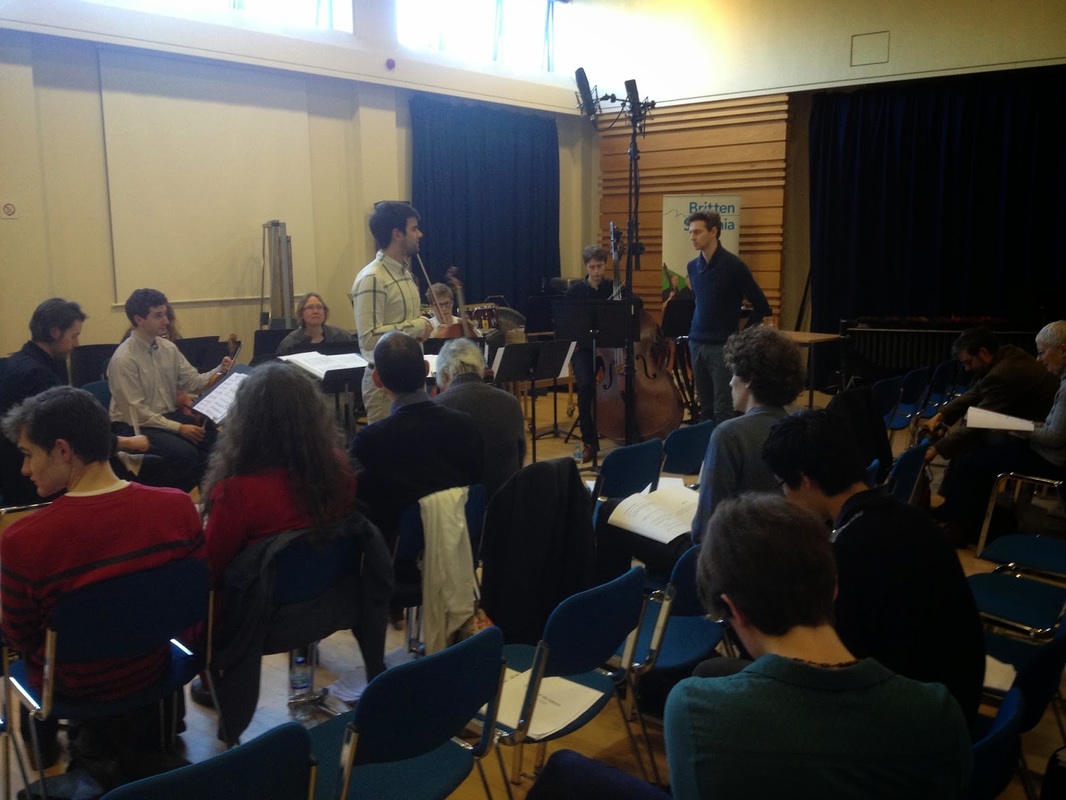 This is a post I wrote for the Britten Sinfonia's blog on Wednesday 11 March, 2015. Cambridge University Composers Workshop - Saturday 7 March 2015 Britten Sinfonia Musicians: Thomas Gould - Violin 1, Bridget Carey - Viola, James Kenny - Double Bass, Peter Francomb - Horn, Huw Watkins - Piano Univeristy of Cambridge Students Musicians: Nicholas Bleisch - Violin 2, Ben Michaels - Cello, Simone Maurer - Flute, Chloe Allison - Clarinet, Carl Wikeley - Percussion Conductor: Hugh Brunt Guest composer: Judith Weir Having moved to Cambridge from Australia five months ago, I was eager to hear the music currently being written by young composers during the Composers Workshop. It also provided an opportunity to explore the music, and record it under tight time pressures, in an ensemble of Cambridge music students and professionals from Britten Sinfonia. The workshop began with an address from composition lecturer Richard Causton who spoke, from what was undoubtedly a personal experience, about the journey of a composer’s work: from an imaginary representation inside their head, to the first time they actually hear it played by a real ensemble in real time. He warned the students the experience could be shocking, but it would allow them a unique opportunity to fine tune their composing. Eminent composer, Judith Weir, attended the workshop to give advice to the students. I played flute and piccolo in 4 of the 6 compositions, all of which had a distinctly different style and story. Bertie Baigent’s Mr Hetherington’s Hat for eight players which, in his words, was “inspired by the story of John Hetherington, the haberdasher once supposed to have been the inventor of the top hat… This work captures the atmosphere at the first sight of the hat: the astonishment of the crowd, and the jovial insouciance of Mr Hetherington.” Bertie used very little material for the composition and combined the instruments in groups of unison which were framed with short and punchy silences. As the players and conductor, Hugh Brunt, became more familiar with the score, we began to capture the humourous, light character of the piece. Judith praised Bertie’s exhaustive use of sparse material to create a texturally and rhythmically interesting composition. In complete contrast was Alex Tay’s The Bleak Winter which “is a reference to the famous carol and poem. The piece draws inspiration from the first verse, where Christina Rosetti describes the earth, winds, snow, and water, and imagines the four separate elements freezing and crystallising.” The score was complexly layered in regards to rhythmic and melodic elements. Tonal and chordal colours were explored through an emphasis on extended techniques across the instruments. The very dense nature of the composition was aided by the structure which featured a recurring section of semiquavers in the flute part. For many of the instrumentalists, this was the most technically challenging piece of the day, although we also appreciated how hard Alex must have worked to conceptualise and notate the music. Rhiannon Randle’s Nachtgedanken meaning ‘Night Thoughts’, “depicts lying awake at night plagued with insomnia, and tracks a progression of thoughts on life, death and fate.” I had already played this piece prior to the workshop and found it intriguing to see what a different group of musicians could bring in terms of interpretation. Originally conceived as an orchestral work, Nachtgedanken also worked well for chamber ensemble. Judith noted the piece utilised effects more than harmonic or melodic material, which I thought successfully underpinned the dream-like shifts of the piece. Joy Lisney’s movement I of Sinfonia Piccola is to become a multi-movement small symphony for chamber orchestra which, coincidentally, starts with a lone piccolo note. Much conversation was given to the way in which the piece had been notated. Joy had given a lot of thought as to how she would represent the rhythms across the entire piece. A number of players felt the score looked more difficult than needed and raised some good alternatives to how the notation might be simplified. Initially, I too was troubled by the complex notation, however I realised this was a good opportunity to extend my reading abilities; and that perhaps sometimes notation should challenge the musician. Once I took on this mindset and worked out the subdivisions, I felt I had a better understanding of the piece. In the last hour of the workshop, we gave a concert of all the pieces which were also recorded. This was a demanding process as there was little time to prepare between each piece. Hugh must be commended for not only his preparation of the scores before the workshop, but for his ability to change from the character and style of one piece so quickly to the next. This gave me the opportunity to hear the other two compositions that didn’t require flute. Robert Laidlow’sTraveller of the Inferno incorporated extended string techniques which had me craning my neck to see where the sounds were coming from. Daniel-Lewis Fardon’s Break juxtaposed material for solo cello against the rest of the ensemble, and was perhaps my favourite composition of the day. Credit must go to Ben Michaels for his virtuosic cello playing. Overall, the workshop was a huge success for the composers, ensemble, and audience. It is satisfying to hear such contrasting music being written by young composers in Cambridge. Simone Maurer (Sinfonia Student 2014-15)  I enjoy the concert experience - sitting down and watching one or more musicians perform with polish and flair. It is well known that performers spend enormous amounts of time in the practice room, yet the audience will never know any of that build up; a concept conveyed perfectly by this picture of an iceberg. As a performer myself, I have always been intrigued with knowing what went on before the concert. How do professional musicians prepare their performances? I recently had a rare opportunity to listen in on a pre-concert rehearsal by the Britten Sinfonia wind quintet. Sitting very quietly in the top seats of the West Road Concert Hall, I listened for an hour. The first thing to strike me was the different seating formation of the quintet. Compared to a string quartet, wind quintets allow more flexibility in regards to where the players sit. In my own experience, the following arrangement was common: (from left to right) flute, oboe, bassoon, horn, clarinet. The Britten Sinfonia players sat: bassoon, clarinet, flute, oboe, horn. Never experiencing such a formation, I was unsure how effective the overall sound would be. I was quickly won over. The bassoon and horn created a ‘surround sound’ bass line coming from left and right, of which the block of three treble instruments projected over the top. By the time the sound reached the audience, it was a perfect blend. The quintet members did not rehearse every single piece from beginning to end - which I assume was simply not necessary, and they wanted to preserve energy for the concert. Their playing was interspersed with lively, humorous chatter and old stories of concert disasters. The group was clearly more than just five musicians performing a quintet recital; they seemed genuine friends. The issue of leadership in chamber music can often be a challenge, however the members all took turns at directing the flow of the rehearsal. The four recurring focuses of their repertoire during the rehearsal were: communication (particularly who was showing the beat and leading in the other players), tuning chords, keeping a consistent tempo, and negotiating more effective places to breathe. As a student, it is reassuring to know that professional musicians also have to continue developing these challenging areas of chamber music. My ‘behind the scenes’ experience ended as I quietly exited the rehearsal while the quintet had a break between pieces. I began to wonder how hearing the rehearsal would affect my experience of the concert. Though, as soon as the quintet sat down to perform, the events of the rehearsal moved to the back of my mind and I was overtaken by the wonderful blend of timbres. 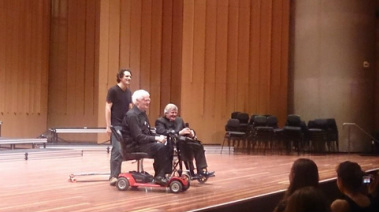 NCM conductors: Alexandre Bloch, Richard Gill, and Geoffrey Lancaster. NCM conductors: Alexandre Bloch, Richard Gill, and Geoffrey Lancaster. Part 2 of my report on AYO’s 2014 NMC. Alexander Orchestra repertoire week 2: Sergei Rachmaninov The Youth Symphony Johannes Brahms Symphony No. 2 I adore Brahms. My perception of him as a composer, and as a person, changes every time I hear a new recording of his compositions. Which makes me curious to always investigate further. I remember the first composition I played by Brahms. It was an Intermezzo for piano that was required for an eisteddfod. I was put off straight away by how the music looked on the page. Nevertheless, I pursued with much help from my teacher who did her best to convey the complexities to my then 15 year old self. I came to enjoy the piece immensely and believed that I was communicating the troubled emotion rather well. However, the eisteddfod adjudicator did not agree, saying “you need to play less like a little sunny girl from Queensland and more like an ugly old man who’s had more than three major disappointments in his life”. Those words stung, and I turned my back on Brahms for quite a while. My sore spot with Brahms was healed however, when I went to the QLD Conservatorium to study my B.Mus and heard wonderful sonatas for clarinet, violin, and piano. The only prior orchestral playing experience I had of Brahms was his Symphony No. 3 a few years ago with the Second Queensland Youth Orchestra. I had been waiting excitedly in anticipation during the first week of NMC to play through Brahms’ Symphony No. 2. The Hopkins Orchestra had played Brahms’ Symphony No. 4 in the previous week’s concert. Their performance was exhilarating and dramatic. Alexandre Bloch conducted from memory and his active stage presence looked almost choreographed. I think it’s fair to say that when the Alexander Orchestra sat down for the first Brahms rehearsals, we were expecting to prepare for an even more grandiose presentation. This did not happen. Richard Gill walked into our first rehearsal where we were seated and eager to sink our teeth into the Symphony. However, Richard sat on his conductor’s chair and spoke about what was to come. He praised the Hopkins Orchestra performance, but said we would not take a similar approach. He would not just rehearse with us - he would educate and challenge us. Which he certainly did. Rehearsals were intense - much more intense than the Copland. The Copland was physically draining, but the Brahms required more depth, more thinking. Richard frequently stopped to ask questions, probe our observations, and encourage comprehensive listening. It was the most superb example of theory and practical elements put together to enhance the performance. Richard spent rehearsal time discussing with us how the Symphony movements connect with one another to give a better overall experience of the composition. In the fourth day of rehearsals, Richard said the most conflicting statement I have heard based on my 16 years of musical education: ‘Brahms is a classical composer’. This sent my head spinning! Speechless, I turned to the people around me. Yet, no one looked phased. All my life, I had read and believed strongly that Brahms was a romantic composer. Richard went on to say we would perform this piece with a classical interpretation. He demonstrated by conducting us through a transition passage where he made a dramatic deceleration into the new section - even though there was no such instruction to. When asked who in the orchestra thought that was musically appropriate, most people responded with yes. Even I thought despite the instruction not being printed on the page, many recordings have very romantic interpretations like that. Richard admitted that from the 60s/70s, such an interpretation was stylistically normal. However, he encouraged us to honour the score and incorporate classical techniques. At NMC were a few classical and baroque specialists who showed us the hierarchy of the music and how to communicate that via articulation, phrasing, dynamics and ensemble balance. I’m still unsure of how I feel about Richard’s statement, particularly after reading this interview where he talks about Brahms’ influence in the romantic era: http://www.canberratimes.com.au/entertainment/music/nurturing-seeks-to-enlighten-20131231-304gl.html. I have, though, taken away a greater trust in playing what is on the page, and to not succumb to a romantic interpretation in the hope it will delight the audience more. When it came to the performance, we did not present an edge-of-the-seat rendition and certain parts weren’t perfectly polished, but everyone in that orchestra was a better musician than at the start of the week. We were richer in knowledge by ‘learning how to learn’ so to speak, and have the ability to take those musical processes with us to our next orchestral engagement. This, I believe, is what NMC strives to achieve. In my opinion, we all have Richard Gill to thank for that. A little bit about Richard… Before NMC, I had never met Richard Gill in person. His name was in every major music publication, yet none of them had done real justice to him. We all came to cherish Richard’s speeches which uplifted and united us. He has the most amazing memory (memorising everyone’s name in the orchestra by the end of the first rehearsal) and surprisingly communicates with pop culture references and modern ‘lingo’. See my favourite quote by Richard at the end of this post. To wrap up, Richard is passionate, selfless, and totally committed to a composer’s intentions and the education of young Australians. Viva la Richard Gill!! “Even Brahms knew he was using clever compositional techniques and said ‘Ich bin totes cool.’” -Richard Gill, 2014 National Music Camp  From January 5-19, the Australian Youth Orchestra (AYO) held its annual National Music Camp (NMC). 2014 was my first NMC experience. Here’s part 1 of my report on the 2 weeks at the Australian National University, Canberra. Around 200 orchestral program participants aged 14-22 were split into three orchestras: 1. Hopkins Chamber Orchestra conducted by Geoffrey Lancaster 2. Bishop Orchestra conducted by Alexandre Bloch 3. Alexander Orchestra conducted by Richard Gill I played flute and piccolo in the Alexander Orchestra. Alexander Orchestra repertoire week 1: Andrew Howes Ichirós Aaron Copland Symphony No. 3 Ichirós was written by Sydney-born composer Andrew Howes and commissioned by Richard Gill and Silo Collective, specifically for NMC. I won’t attempt to describe the music in my own words. Rather, I’ll leave it for Andrew himself. He discusses the work, and his compositional style in this interview - http://www.cutcommon.com/#!Subverting-Expectations-composer-Andrew-Howes/c1ax0/691D4A9F-A0D5-43CD-B9B1-F439C1B57BC6. It also has a link to SoundCloud where you can hear the performance in full. Listening to the recording made me experience the piece in a completely different way (perhaps because I wasn’t in performance mode). I heard more nuances and understood the work more as a whole. Andrew certainly is developing successful compositional techniques which create interesting instrumental colours. Sitting in the middle of the orchestral sound I wasn’t always convinced, however on hearing the recording I have changed my mind decidedly. Hard to believe he’s only 21! Before NMC, I had been relatively unaware of Copland’s symphonic endeavours. My listening experience extended solely to his woodwind repertoire. In Symphony No. 3, I played flute/piccolo along with two other flutes and another piccolo. The entire woodwind section was augmented. After the first rehearsal, I don’t think we fully anticipated how much stamina would be required for this mammoth work. Rehearsals were demanding with intonation, balance, and portraying the “bigger picture” of the work as prime challenges. Although it wasn’t spoken about much, on the concert night we - a collective of strangers who had known each other for one week - learnt to trust, lead, follow, and cope when things went amiss. This made me reflect on how different an orchestra is to most other workplaces. Workers (musicians) produce their own slice of creativity (comprising of their own knowledge, skills, past experiences, feelings, emotions, etc.) and are expected to engage with other workers’ slices to create a subsequent, uniform creative outcome (the performance). Honestly, I’m (pleasantly) surprised that more arguments on a personal scale don’t occur. Perhaps that’s why it’s so crucial to have a good leader - of which Richard Gill deserves all credit for. Staggering off stage after the 45 minute performance, a buzz of camaraderie was felt among my fellow musicians - a sure sign that we would step up for the following week’s concert. “Most people… use music as a couch; they want to be pillowed on it, relaxed and consoled for the stress of daily living. But serious music was never meant to be used as a soporific.” -Aaron Copland Reminiscing about past concerts in Mackay... After completing my high school studies in 2009, I wanted to show my appreciation to family, friends, and the Mackay community. With the help of my piano teacher, I organised a flute and piano concert at the Central Queensland Conservatorium of Music, Mackay. The concert was free, and my mother put on an afternoon tea to follow. In 2010, I moved to Brisbane to begin studying flute with Gerhard Mallon at the Queensland Conservatorium of Music. Although for the following four years I was primarily based in Brisbane, I returned home to give an annual flute and piano concert. From 2011, the concerts were held at the Trinity Anglican Church and donations raised were given to the church organ restoration fund. I have themed my later concerts. In 2012 I chose my repertoire based around fairy tales, fables and fantasies. After noticing music inspired by birds is often synonymous with the flute, I chose an Aves theme for my 2013 concert. Performing Alan Ridout's The Emperor and the Bird of Paradise was particularly fun (watch the YouTube video below). I hope to present another performance in 2014 - perhaps with a circus theme! Past concert flyers and programmes are listed in my Mackay Concerts tab (found in the drop-down menu under Concerts). "Creativity takes courage" - Henri Matisse |
|

